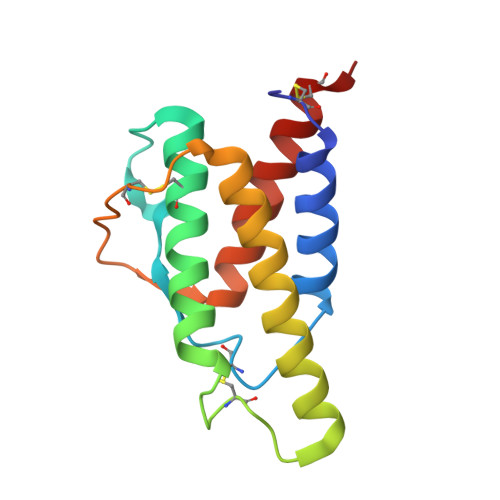A modular interface of IL-4 allows for scalable affinity without affecting specificity for the IL-4 receptor
Kraich, M., Klein, M., Patino, E., Harrer, H., Nickel, J., Sebald, W., Mueller, T.D.(2006) BMC Biol 4: 13-13
- PubMed: 16640778
- DOI: https://doi.org/10.1186/1741-7007-4-13
- Primary Citation of Related Structures:
2B8U, 2B8X, 2B8Y, 2B8Z, 2B90, 2B91, 2D48 - PubMed Abstract:
Interleukin 4 (IL-4) is a key regulator of the immune system and an important factor in the development of allergic hypersensitivity. Together with interleukin 13 (IL-13), IL-4 plays an important role in exacerbating allergic and asthmatic symptoms. For signal transduction, both cytokines can utilise the same receptor, consisting of the IL-4Ralpha and the IL-13Ralpha1 chain, offering an explanation for their overlapping biological functions. Since both cytokine ligands share only moderate similarity on the amino acid sequence level, molecular recognition of the ligands by both receptor subunits is of great interest. IL-4 and IL-13 are interesting targets for allergy and asthma therapies. Knowledge of the binding mechanism will be important for the generation of either IL-4 or IL-13 specific drugs. We present a structure/function analysis of the IL-4 ligand-receptor interaction. Structural determination of a number of IL-4 variants together with in vitro binding studies show that IL-4 and its high-affinity receptor subunit IL-4Ralpha interact via a modular protein-protein interface consisting of three independently-acting interaction clusters. For high-affinity binding of wild-type IL-4 to its receptor IL-4Ralpha, only two of these clusters (i.e. cluster 1 centered around Glu9 and cluster 2 around Arg88) contribute significantly to the free binding energy. Mutating residues Thr13 or Phe82 located in cluster 3 to aspartate results in super-agonistic IL-4 variants. All three clusters are fully engaged in these variants, generating a three-fold higher binding affinity for IL-4Ralpha. Mutagenesis studies reveal that IL-13 utilizes the same main binding determinants, i.e. Glu11 (cluster 1) and Arg64 (cluster 2), suggesting that IL-13 also uses this modular protein interface architecture. The modular architecture of the IL-4-IL-4Ralpha interface suggests a possible mechanism by which proteins might be able to generate binding affinity and specificity independently. So far, affinity and specificity are often considered to co-vary, i.e. high specificity requires high affinity and vice versa. Although the binding affinities of IL-4 and IL-13 to IL-4Ralpha differ by a factor of more than 1000, the specificity remains high because the receptor subunit IL-4Ralpha binds exclusively to IL-4 and IL-13. An interface formed by several interaction clusters/binding hot-spots allows for a broad range of affinities by selecting how many of these interaction clusters will contribute to the overall binding free energy. Understanding how proteins generate affinity and specificity is essential as more and more growth factor receptor families show promiscuous binding to their respective ligands. This limited specificity is, however, not accompanied by low binding affinities.
Organizational Affiliation:
Lehrstuhl für Physiologische Chemie II, Theodor-Boveri Institut für Biowissenschaften (Biozentrum) der Universität Würzburg, Am Hubland, D-97074 Würzburg, Germany. kraich@biozentrum.uni-wuerzburg.de















